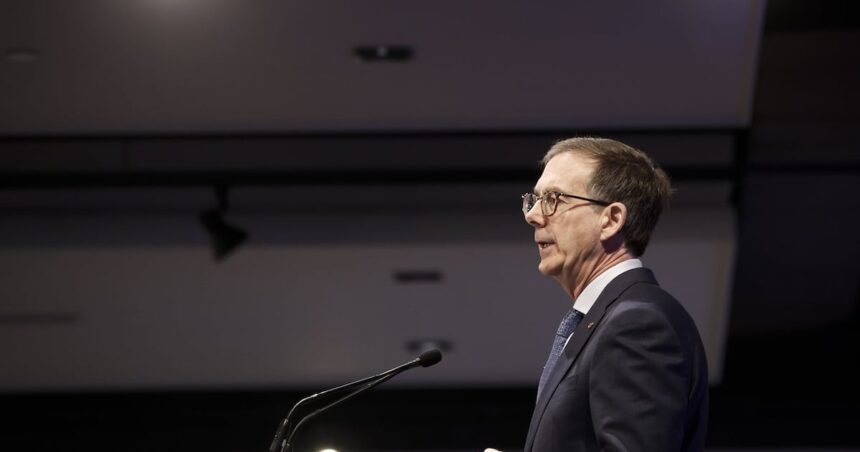The looming specter of American tariffs has ignited fresh urgency in Canada’s economic policy circles, with the Bank of Canada Governor offering his most direct guidance yet on insulating the Canadian economy from volatile trade relationships.
During testimony to the Senate banking committee yesterday, Tiff Macklem emphasized that Canada must accelerate efforts to build commercial relationships beyond its traditional American market dependence. “The United States is always going to be our largest trading partner given geography, given history, given the integration of our economies,” Macklem acknowledged. “But diversification of our trading relationships can help build resilience.”
The governor’s comments reflect growing concern about Canada’s vulnerability to U.S. trade policy shifts. With approximately 75% of Canadian exports heading south across the border, the prospect of Donald Trump’s promised 10% blanket tariff on Canadian goods has sent economists scrambling to model potential impacts.
I’ve spent the past week speaking with trade specialists in Ottawa and Washington about the practical implications of Macklem’s recommendation. The consensus view suggests that while diversification sounds straightforward in theory, the implementation poses significant challenges.
“Canada has been talking about trade diversification since the 1970s,” explains Meredith Lilly, former trade advisor to Prime Minister Stephen Harper and current Simon Reisman Chair at Carleton University. “The problem isn’t lack of awareness – it’s that geographic proximity and integrated supply chains create powerful economic gravity that’s difficult to overcome.”
Indeed, Statistics Canada data reveals that despite numerous free trade agreements with Europe, Pacific nations, and elsewhere, the percentage of exports going to non-U.S. markets has increased only marginally over the past decade. This reality underscores the substantial barriers to meaningful diversification.
The Bank of Canada’s economic modeling suggests even modest U.S. tariffs could significantly impact Canadian growth. Their analysis indicates that a 10% tariff on Canadian exports would reduce domestic GDP by approximately 0.8 to 1.2 percentage points over the first year – a substantial hit for an economy already struggling with sluggish productivity.
When pressed by senators about specific sectors most capable of diversification, Macklem pointed to several promising areas. “Services, particularly digital services, face fewer geographic constraints,” he noted. “Similarly, high-value manufactured goods where transportation costs represent a smaller percentage of overall value could more easily access distant markets.”
From Brussels, where I attended EU-Canada trade consultations last month, European officials expressed receptiveness to deepening commercial ties but highlighted persistent challenges. “We’ve seen limited uptake of CETA opportunities by Canadian businesses,” one senior EU trade official told me, speaking on background. “The agreement created potential, but realizing it requires businesses to actively develop market knowledge and relationships.”
The Statistics Canada trade data backs this assessment. Despite the Canada-European Union Comprehensive Economic and Trade Agreement (CETA) being provisionally applied since 2017, Canadian exports to the EU have grown more slowly than overall export growth.
Macklem’s comments align with recommendations from Canada’s business community. Perrin Beatty, president of the Canadian Chamber of Commerce, has been advocating for a more coordinated approach to trade diversification. “We need a whole-of-government strategy that aligns diplomatic resources, export financing, and regulatory harmonization around specific high-potential markets,” Beatty said at a Toronto economic forum last week.
The immediate challenge for policymakers is balancing long-term diversification against potential short-term shocks. The Department of Finance has been quietly developing contingency plans for possible U.S. tariffs, according to two senior officials who requested anonymity to discuss sensitive preparations.
These contingency measures reportedly include targeted support for vulnerable industries, accelerated regulatory approvals for projects that could boost non-U.S. exports, and potential retaliatory tariffs designed to create negotiating leverage.
Visiting automotive parts manufacturers in Windsor last month, I witnessed firsthand the anxiety about potential disruption. “We’ve spent decades optimizing our production for just-in-time delivery across the border,” explained Maria Gonzalez, operations director at a tier-one supplier. “Reorienting to distant markets would require entirely different logistics, inventory management, and product specifications.”
Beyond the economics, trade diversification touches on broader strategic concerns. As geopolitical competition intensifies between major powers, Canada’s heavy economic dependence on a single partner creates vulnerability.
“Economic security increasingly means avoiding excessive concentration risk,” notes Roland Paris, former foreign policy advisor to Prime Minister Justin Trudeau and professor of international affairs at the University of Ottawa. “The challenge is pursuing diversification without appearing to turn away from our most important relationship.”
Macklem’s testimony stopped short of specific policy prescriptions, maintaining the central bank’s traditional independence from direct government advice. However, his emphasis on trade resilience represents a notable evolution in the Bank’s public messaging about economic risks.
Whether Canada can meaningfully diversify its trade remains an open question. Geographic realities and deeply integrated continental supply chains create powerful economic gravity. Yet as political volatility threatens to disrupt long-standing trading patterns, the economic case for developing alternatives grows stronger – regardless of how challenging implementation might prove.






